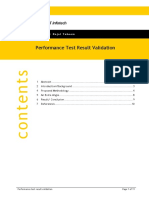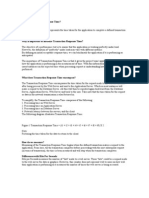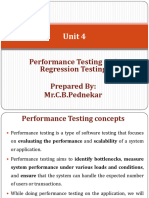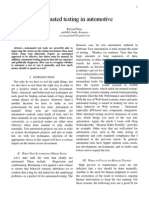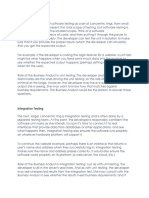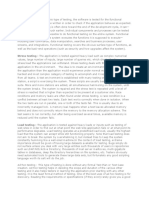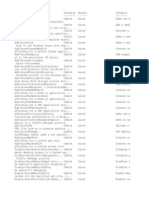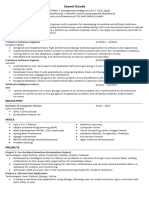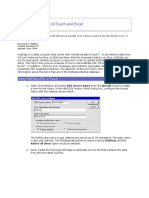PerformanceTesting Little's Law
PerformanceTesting Little's Law
Uploaded by
mnagabhushanCopyright:
Available Formats
PerformanceTesting Little's Law
PerformanceTesting Little's Law
Uploaded by
mnagabhushanOriginal Description:
Copyright
Available Formats
Share this document
Did you find this document useful?
Is this content inappropriate?
Copyright:
Available Formats
PerformanceTesting Little's Law
PerformanceTesting Little's Law
Uploaded by
mnagabhushanCopyright:
Available Formats
Ensuring Accuracy in Performance Testing Most of the time applications may face performance issues even after rigorous
performance validation. This is primarily because of improper performance test environment setup and model. It is a common issue across the industry that the testing tool might not have performed correctly during the load testing. So it is always a best practice and a mandate to validate that the testing tool simulates the network traffic as expected genuinely and to ensure the test environment is also accurate. Here is an idea, how Queuing theory Laws can be applied in validating the Performance test accuracy and to ensure that the application has a smooth accessibility in production without performance issues. Littles Law The long-term average number of customers in a stable system L is equal to the long-term average effective arrival rate, , multiplied by the average time a customer spends in the system, W and it is expressed algebraically, L = W Applying Littles Law in Performance Testing The Average number of (virtual) users N in the system (server) at any instance is equal to the product of average throughput X and average response time Z. It is expressed algebraically, N= X * (Z + R), where R=think time Demonstration of Littles Law to ensure Performance Testing From the results obtained from the performance testing tool, we can find how many actual users have been generated to test the application using Littles Law. A sample load test done on a sample application with 10 users has obtained following test results. Average Transactions/sec=1.7, Average transaction response time=0.5 sec, Average Think time=5sec By Littles Law, Number of virtual users emulated by the performance testing tool is, N=X*(Z+R) =1.7*(0.5+5) N=9.3510 virtual users have been emulated during load test If the actual virtual users used in the system is equal to the Littles Law result, then neither the tool nor the server has undergone any problem. If the Littles Law result is less than the actual virtual users, then it means remaining users were idle throughout the test. * It is understood that the throughput data above has been extracted from the tool but it is always preferred and a best practice to use the throughput data from the server.
Little's Law [Professor John D.C. Little] - Verify Performance Test Results Here is something I often use (and need to lookup) when I'm analyzing performance test reports. Most of the time, these reports are nothing but nebulous and I have no choice but to go back to the basics. Here's the simple procedure I use to verify the sanity of the test: Run a step load test. Get the following data from your load testing tool (averaged) per step: 1. Transactions per second 2. Hits per second 3. Think time 4. Response time 5. Number of virtual users being simulated. 6. Throughput (bytes)
Here's where the math starts: Using Little's Law, you then then deduces the following: Actual Number of Users in the System = (Response time + Think time) * Transactions per second You can also verify the page size: Page size = Throughput / Hits per second You can tell if there is something wrong with your test bed if the actual number of users in the system given by Little's Law is different from the number of virtual users being pumped in by your load testing tool. I.e. if the number of users simulated by the testing tool is more than what you deduce by Little's Law, your system is probably just queuing those extra users. You'll also notice your response time will start to 'knee' once this starts to happen. The main thing here is to do this calculation for an average of all points data points per step change in number of virtual users simulated.
You might also like
- Isc Chapter 3Document44 pagesIsc Chapter 3Cristina Joy CruzNo ratings yet
- Client Server Architecture A Complete Guide - 2020 EditionFrom EverandClient Server Architecture A Complete Guide - 2020 EditionNo ratings yet
- 1132 Performance Testing Ebooklet Albert Witt FinalDocument15 pages1132 Performance Testing Ebooklet Albert Witt FinalDanny PhamNo ratings yet
- BMS-0000356 - Part Number Definition - Rev04Document2 pagesBMS-0000356 - Part Number Definition - Rev04Cristian NarroNo ratings yet
- SOP 0103 Document Management System 1Document8 pagesSOP 0103 Document Management System 1Agil MahendraNo ratings yet
- Selenium with C#: Learn how to write effective test scripts for web applications using Selenium with C# (English Edition)From EverandSelenium with C#: Learn how to write effective test scripts for web applications using Selenium with C# (English Edition)No ratings yet
- Operational acceptance testing Complete Self-Assessment GuideFrom EverandOperational acceptance testing Complete Self-Assessment GuideNo ratings yet
- Software Development Process Models A Complete Guide - 2020 EditionFrom EverandSoftware Development Process Models A Complete Guide - 2020 EditionNo ratings yet
- Little's LawDocument1 pageLittle's LawursrajuNo ratings yet
- Software Testing-Performance TDocument21 pagesSoftware Testing-Performance TTridip BaruaNo ratings yet
- Artillery APIDocument25 pagesArtillery APIRohit AichNo ratings yet
- Performance Test Result Validation: AUTHOR: Rajat TaheemDocument11 pagesPerformance Test Result Validation: AUTHOR: Rajat TaheemKeith MoNo ratings yet
- What Is Transaction Response Time?Document64 pagesWhat Is Transaction Response Time?neovik82No ratings yet
- Performance TestingDocument18 pagesPerformance TestingTeakadai Productions100% (1)
- Engineering TechniquesDocument4 pagesEngineering TechniquesRaia AlabyuNo ratings yet
- unit 4 stqaDocument31 pagesunit 4 stqaAnisha PatilNo ratings yet
- Martin Joo - Performance With Laravel Sample ChapterDocument65 pagesMartin Joo - Performance With Laravel Sample ChapterAgabalaNo ratings yet
- How To Write A Performance Test CaseDocument10 pagesHow To Write A Performance Test CasesumanchennaNo ratings yet
- Measuring End-User Availability On The Web: Practical ExperienceDocument5 pagesMeasuring End-User Availability On The Web: Practical ExperienceDhery Tri MNo ratings yet
- Rapid Bottleneck Identification: A Better Way To Load TestDocument8 pagesRapid Bottleneck Identification: A Better Way To Load Testaustinfru7No ratings yet
- Load Runner User GuideDocument12 pagesLoad Runner User Guideapi-3738664100% (2)
- Performance TestingDocument4 pagesPerformance TestingAnandNo ratings yet
- Testing in Which All Paths in The Program Source Code Are Tested at Least OnceDocument5 pagesTesting in Which All Paths in The Program Source Code Are Tested at Least OnceSrikanth GuruNo ratings yet
- AssignmentDocument12 pagesAssignmentaliyumuhammad9990No ratings yet
- Objectives and ScopeDocument8 pagesObjectives and Scopedewang goelNo ratings yet
- Key Considerations in Performance Testing: Leslie Segal President Testware Associates, IncDocument9 pagesKey Considerations in Performance Testing: Leslie Segal President Testware Associates, IncVijay GolaganiNo ratings yet
- Performance Engineering DOCSDocument14 pagesPerformance Engineering DOCSPrateek GuptaNo ratings yet
- What Is Client-Server and Web Based Testing and How To Test These ApplicationsDocument9 pagesWhat Is Client-Server and Web Based Testing and How To Test These ApplicationssvelamaNo ratings yet
- Performance Testing Interview Questions With Answers: By:P2CinfotechDocument10 pagesPerformance Testing Interview Questions With Answers: By:P2CinfotechPrateek JainNo ratings yet
- Describe Common Problems of Test Automation?: FunctionalityDocument7 pagesDescribe Common Problems of Test Automation?: Functionalityvivekranjan1980No ratings yet
- Performance TestingDocument27 pagesPerformance TestingMadhavan KNo ratings yet
- Objectives and ScopeDocument9 pagesObjectives and Scopedewang goelNo ratings yet
- Performance Testing Presentation On 03julyDocument36 pagesPerformance Testing Presentation On 03julySreenivasulu Reddy SanamNo ratings yet
- Performance vs. Load vs. Stress TestingDocument4 pagesPerformance vs. Load vs. Stress TestingBanhiNo ratings yet
- Totally Data Driven Automated TestingDocument17 pagesTotally Data Driven Automated TestingHareen ReddyNo ratings yet
- Load RunnerDocument38 pagesLoad RunnerRajan SinghNo ratings yet
- Knowledge Database Support Tool: Title Description/ PurposeDocument7 pagesKnowledge Database Support Tool: Title Description/ Purposevisha_sNo ratings yet
- Automated Testing in AutomotiveDocument4 pagesAutomated Testing in AutomotiveRazvan PelauNo ratings yet
- Business Analyst Testing DocumentDocument7 pagesBusiness Analyst Testing DocumentAdetunji TellaNo ratings yet
- LtestngDocument179 pagesLtestngshirokorigawaNo ratings yet
- What Is Fuzz TestingDocument8 pagesWhat Is Fuzz Testingavumaa22No ratings yet
- 1 Load Testing Guide: Term DescriptionDocument1 page1 Load Testing Guide: Term DescriptionDinesh KumarNo ratings yet
- Analysis: Implementing A New Computer SystemDocument3 pagesAnalysis: Implementing A New Computer SystemgkumarsinghNo ratings yet
- What Is The Difference Between Testing and Commissioning?Document6 pagesWhat Is The Difference Between Testing and Commissioning?durga5372No ratings yet
- Load Testing Using NeoloadDocument32 pagesLoad Testing Using NeoloadlaxmanbethapudiNo ratings yet
- C V VVV VVV VVV VV VDocument5 pagesC V VVV VVV VVV VV Vshankar_mpNo ratings yet
- Web TestingFunctionality TestingDocument7 pagesWeb TestingFunctionality TestingkiruthikaveluNo ratings yet
- Best Practices For Load TestingDocument9 pagesBest Practices For Load Testing65bangorNo ratings yet
- Why Did My PC Suddenly Slow Down?Document6 pagesWhy Did My PC Suddenly Slow Down?samhardworkerNo ratings yet
- Happy Path TestingDocument2 pagesHappy Path Testingmimo1911No ratings yet
- Software TestingDocument312 pagesSoftware TestingAman SaxenaNo ratings yet
- 37 Most Common LoadRunner Interview Questions and Best AnswersDocument8 pages37 Most Common LoadRunner Interview Questions and Best AnswersvickysparkNo ratings yet
- G S BPM S: Etting Tarted With ImulationDocument19 pagesG S BPM S: Etting Tarted With Imulationteletranx8543No ratings yet
- CMU-CS 462 - Software Meassurement and Analysis - 2020S - Lecture Slides - 13Document55 pagesCMU-CS 462 - Software Meassurement and Analysis - 2020S - Lecture Slides - 13Anh HoaiNo ratings yet
- Abhishek Chauhan: ExperienceDocument2 pagesAbhishek Chauhan: ExperienceAbhishek ChauhanNo ratings yet
- Center: Aswan Database Assignment: B) Database Management SystemDocument14 pagesCenter: Aswan Database Assignment: B) Database Management SystemMohammed MadanyNo ratings yet
- Cognos CubesDocument8 pagesCognos CubesMANOJ KUMAR REDDYNo ratings yet
- Azure Powershell CmdletsDocument9 pagesAzure Powershell CmdletsSunil KatkeNo ratings yet
- A Technical Seminar Report: Submitted in Partial Fulfilment of The Requirement For The Award of The Degree ofDocument24 pagesA Technical Seminar Report: Submitted in Partial Fulfilment of The Requirement For The Award of The Degree ofcsed 1819No ratings yet
- Getting Started With Apache Kafka in Python - Towards Data Science PDFDocument17 pagesGetting Started With Apache Kafka in Python - Towards Data Science PDFDeven MaliNo ratings yet
- Saeed Mohamed Ahmed Gooda - SEDocument1 pageSaeed Mohamed Ahmed Gooda - SEsaeedgooda219No ratings yet
- (R18A0513) Python ProgrammingDocument183 pages(R18A0513) Python ProgrammingapurbapatraNo ratings yet
- AZ 400 NotesDocument6 pagesAZ 400 NotesBojan BogdanovicNo ratings yet
- DATA MODELING NotesDocument8 pagesDATA MODELING NotesMax GxNo ratings yet
- Technical: IEC TR 62443-2-3Document8 pagesTechnical: IEC TR 62443-2-3alex logNo ratings yet
- Sap Cloud Applications StudioDocument864 pagesSap Cloud Applications StudioRobson JulianoNo ratings yet
- Cyber SecurityDocument16 pagesCyber SecurityJepri Yanta SurbaktiNo ratings yet
- Design and Implementation of ERP Software in Material Supply ChaiDocument79 pagesDesign and Implementation of ERP Software in Material Supply ChaiKunal ThakareNo ratings yet
- System Development Life Cycle SDLCDocument10 pagesSystem Development Life Cycle SDLCtaiba tariqNo ratings yet
- Quize 1 There Are Several Different Deployments of Qlik SenseDocument19 pagesQuize 1 There Are Several Different Deployments of Qlik SenseFrancisco SantizoNo ratings yet
- Sol Ass 4Document11 pagesSol Ass 4Yogesh GandhiNo ratings yet
- Job Description Senior Software EngineerDocument4 pagesJob Description Senior Software EngineershasunderNo ratings yet
- Data Sheet Ultrastar DC hc310 PDFDocument2 pagesData Sheet Ultrastar DC hc310 PDFKhairul AzfarNo ratings yet
- 3.0 Cyber Security NotesDocument76 pages3.0 Cyber Security NotesElizabeth KalekyeNo ratings yet
- Tech Note 91 - Using HistData With InTouch and ExcelDocument11 pagesTech Note 91 - Using HistData With InTouch and ExcelAlex RamírezNo ratings yet
- Implementasi Aplikasi Android-Based Untuk Penanggulangan Well Kick Pada Pemboran Minyak Dan Gas BumiDocument10 pagesImplementasi Aplikasi Android-Based Untuk Penanggulangan Well Kick Pada Pemboran Minyak Dan Gas BumiRaditheo ZeoNo ratings yet
- Banking Test Cases - MANUAL TEST CASESDocument2 pagesBanking Test Cases - MANUAL TEST CASESTushar kathalkar100% (1)
- IT Audit Domain 1 - v3Document81 pagesIT Audit Domain 1 - v3rewNo ratings yet
- Collection FrameworkDocument4 pagesCollection FrameworkSaurabh KothariNo ratings yet
- Inst CR WinuxDocument242 pagesInst CR Winuxdprabhu100% (3)
- Jack Link's Beefs Up ERP Solution With MS Dynamics NAVDocument4 pagesJack Link's Beefs Up ERP Solution With MS Dynamics NAVFarayi ChambatiNo ratings yet




















